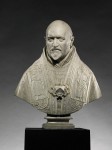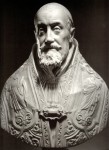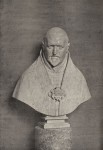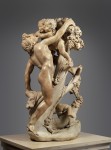 The J. Paul Getty Museum in Los Angeles has acquired the recently rediscovered Bust of Pope Paul V carved in 1621 by Baroque master Gian Lorenzo Bernini. The bust was known to art historians from an 1893 photograph, a bronze copy now in the Statens Museum for Kunst in Copenhagen that was cast by Sebastiano Sebastiani right after the marble original was sculpted, and from Vatican archives detailing the commission of the marble and bronze versions, but it had been secreted in unknown private collections since the 19th century. It recently resurfaced in a private collection and the Getty was contacted by Sotheby’s to arrange a private sale. Obviously the museum was more than interested and since it has an enormous endowment, money was no object. We don’t know what they paid for it, but it was certainly multiple millions of dollars.
The J. Paul Getty Museum in Los Angeles has acquired the recently rediscovered Bust of Pope Paul V carved in 1621 by Baroque master Gian Lorenzo Bernini. The bust was known to art historians from an 1893 photograph, a bronze copy now in the Statens Museum for Kunst in Copenhagen that was cast by Sebastiano Sebastiani right after the marble original was sculpted, and from Vatican archives detailing the commission of the marble and bronze versions, but it had been secreted in unknown private collections since the 19th century. It recently resurfaced in a private collection and the Getty was contacted by Sotheby’s to arrange a private sale. Obviously the museum was more than interested and since it has an enormous endowment, money was no object. We don’t know what they paid for it, but it was certainly multiple millions of dollars.
 The work was one of pair of busts commissioned by Paul V’s nephew and an important early patron of Bernini’s, Cardinal Scipione Borghese.Paul V, a patron in his own right who employed Pietro Bernini, Gian Lorenzo’s father, is said to have seen some drawings done by Gian Lorenzo when he was a boy and declared “This boy will be the Michelangelo of his age.” The other bust in the pair was of Paul V’s successor Pope Gregory XV who was actually pope when Bernini carved both busts. It is now in the private collection of Joseph M. and Toby Tanenbaum. You can see how similar they are in the dignified demeanor of the popes and in the decorative carving of their garments.
The work was one of pair of busts commissioned by Paul V’s nephew and an important early patron of Bernini’s, Cardinal Scipione Borghese.Paul V, a patron in his own right who employed Pietro Bernini, Gian Lorenzo’s father, is said to have seen some drawings done by Gian Lorenzo when he was a boy and declared “This boy will be the Michelangelo of his age.” The other bust in the pair was of Paul V’s successor Pope Gregory XV who was actually pope when Bernini carved both busts. It is now in the private collection of Joseph M. and Toby Tanenbaum. You can see how similar they are in the dignified demeanor of the popes and in the decorative carving of their garments.
Bernini’s portrait of Paul V depicts the pope almost bareheaded, his hair cut in the “tonsure of St. Peter,” which signified the renunciation of worldly fashion, and dressed in traditional pontifical vestments. The thick cope covering his shoulders is richly decorated with embroideries of the Apostles Peter and Paul – the saintly patrons of Rome – with borders of plant motifs. The cope is fastened in the middle of the chest by a complex brooch called a morse, composed of a gemstone set in an elaborate metallic frame. Underneath the cope is a surplice in thin fabric with small vertical pleats on the chest, an embroidered upper edge and a very fine, delicately carved, lace border at the neck.
“Bust of Pope Paul V exemplifies Bernini’s precocious mastery in capturing his sitters’ characters and in conveying a powerful liveliness of expression,” said Anne-Lise Desmas, head of Sculpture and Decorative Arts at the Getty Museum. “Beyond its extraordinary naturalism, the sculpture manages to combine a gravitas appropriate to the Pope’s status with an air of kindness and approachability. In addition, the rich embroidery decoration of the cope is technically a tour de force in low-relief carving. Remarkably, the portrait survived through all these centuries in perfect condition.”
 The bust was in the Borghese family’s enormous art collection until 1893 when it was sold to a non-Italian private collector at an auction of antiquities and artworks at the Villa Borghese in Rome. At the time of the sale the bust was mistakenly attributed to Alessandro Algardi, a sculptor who would become a rival of Bernini’s 15 years or so later, but who didn’t get to Rome until 1625 and even then only worked restoring ancient sculptures for Cardinal Ludovico Ludovisi (Gregory XV’s beloved nephew) for a year or so. The Bust of Paul V was re-attributed to Bernini by Rome’s Inspector of Monuments Antonio Muñoz in a 1916 art journal article. I doubt the Borghese family would have ever sold it had they known it was a Bernini. Another bust of Paul V by Gian Lorenzo Bernini is still in Rome’s Galleria Borghese museum today.
The bust was in the Borghese family’s enormous art collection until 1893 when it was sold to a non-Italian private collector at an auction of antiquities and artworks at the Villa Borghese in Rome. At the time of the sale the bust was mistakenly attributed to Alessandro Algardi, a sculptor who would become a rival of Bernini’s 15 years or so later, but who didn’t get to Rome until 1625 and even then only worked restoring ancient sculptures for Cardinal Ludovico Ludovisi (Gregory XV’s beloved nephew) for a year or so. The Bust of Paul V was re-attributed to Bernini by Rome’s Inspector of Monuments Antonio Muñoz in a 1916 art journal article. I doubt the Borghese family would have ever sold it had they known it was a Bernini. Another bust of Paul V by Gian Lorenzo Bernini is still in Rome’s Galleria Borghese museum today.
Bernini was hugely famous and successful in his lifetime. He had a large studio and much of his work after he hit the big time was physically made by his assistants. When he was very young he collaborated on sculptures with his father. A work like this bust, therefore, that predates the studio but postdates his cooperative works with Pietro, is extremely significant because it was carved by his hand only.
 Sculptures by Bernini are very rare in US museums. The Getty has another one — Boy with a Dragon — but it wasn’t made by Bernini alone; his father Pietro collaborated with his then-teenaged son in its execution. The Metropolitan Museum of Art has another father-son Bernini collaboration, the sculptural group Bacchanal: A Faun Teased by Children, made when Gian Lorenzo was just 18 years old. The Kimbell Art Museum in Fort Worth, Texas, has a pair of terracotta models of angels and the terracotta model for the Fountain of the Moor in Piazza Navona both by Gian Lorenzo. National Gallery of Art in Washington has one of only two other busts in the country, Monsignor Francesco Barberini. The Los Angeles County Museum of Art (LACMA) acquired the other, Portrait of a Gentleman, just this March.
Sculptures by Bernini are very rare in US museums. The Getty has another one — Boy with a Dragon — but it wasn’t made by Bernini alone; his father Pietro collaborated with his then-teenaged son in its execution. The Metropolitan Museum of Art has another father-son Bernini collaboration, the sculptural group Bacchanal: A Faun Teased by Children, made when Gian Lorenzo was just 18 years old. The Kimbell Art Museum in Fort Worth, Texas, has a pair of terracotta models of angels and the terracotta model for the Fountain of the Moor in Piazza Navona both by Gian Lorenzo. National Gallery of Art in Washington has one of only two other busts in the country, Monsignor Francesco Barberini. The Los Angeles County Museum of Art (LACMA) acquired the other, Portrait of a Gentleman, just this March.
With the Getty’s acquisition of Paul V, Los Angeles is now the proud host of two-thirds of the Bernini busts in the US. The bust went on display yesterday for the first time since Gian Lorenzo Bernini put chisel to marble almost 400 years ago.
I hope their anti-earthquake precautions are good.
The article says Bernini received the commission several months after the Pope’s demise. Was he drawing upon someone else’s work to make this?
The Bernini bust of Gregory XV formerly in the Tannenbaum collection was given to the Art Gallery of Ontario in 1997:
http://www.ago.net/agoid22940
There is also a bronze version of Gregory XV in the Museo Civico Medievale in Bologna:
https://www.flickr.com/photos/smbtravels/5626031821